Abstract
Many of the remaining members of the endangered Florida panther (Felis concolor coryi) population suffer from one or more of a variety of physiological, reproductive, endocrine, and immune system defects including congenital heart defects, abnormal sperm, low sperm density, cryptorchidism, thyroid dysfunction, and possible immunosuppression. Mercury contamination, determined to be the cause of death of a female panther in 1989, was presented as the likely cause of thyroid dysfunction. As genetic diversity in the species was less than expected, all of the other abnormalities have been attributed to inbreeding. However, exposure to a variety of chemical compounds, especially those that have been identified as environmental endocrine disrupters (including mercury, p,p'-DDE, and polychlorinated biphenyls), has elicited all of the listed abnormalities in other species. A number of these contaminants are present in South Florida. An exposure pathway has been identified, and evidence presented in this paper, including the fact that there appears to be no significant difference between serum estradiol levels in males and females, suggests that many male panthers may have been demasculinized and feminized as a result of either prenatal or postnatal exposure. Thus, regardless of the effects of inbreeding, current evidence seems to indicate that environmental contaminants may be a major factor contributing to reproductive impairment in the Florida panther population.
Full text
PDF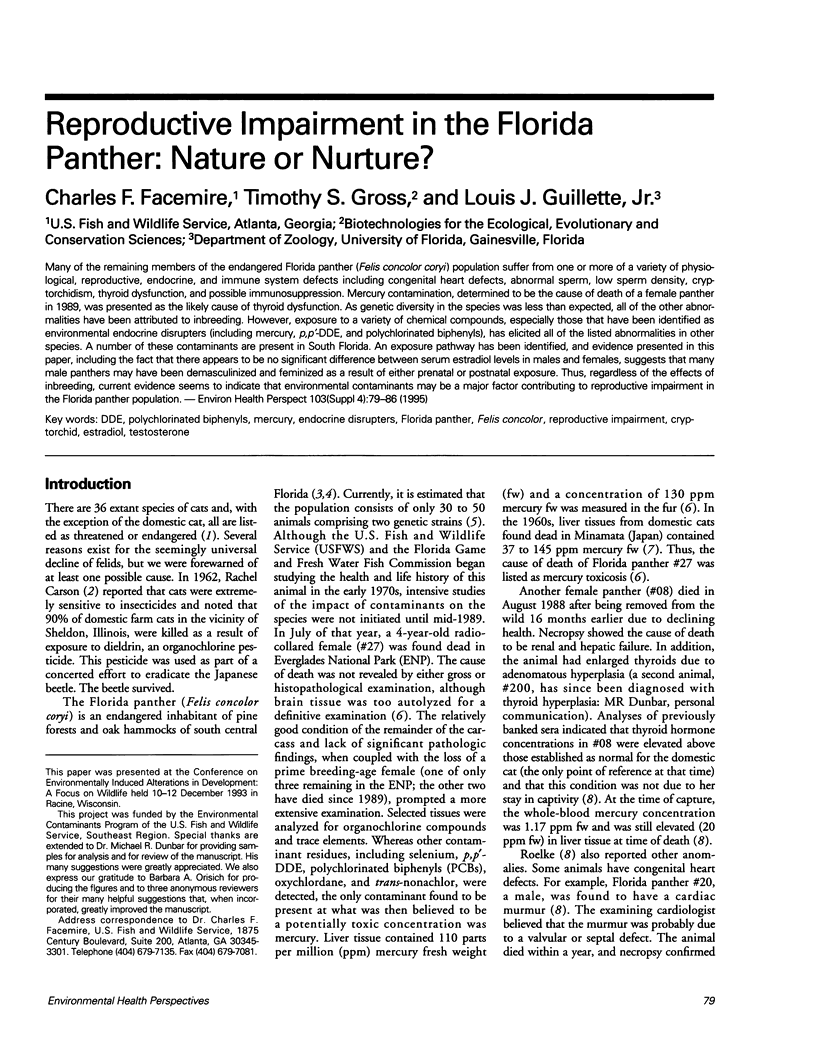
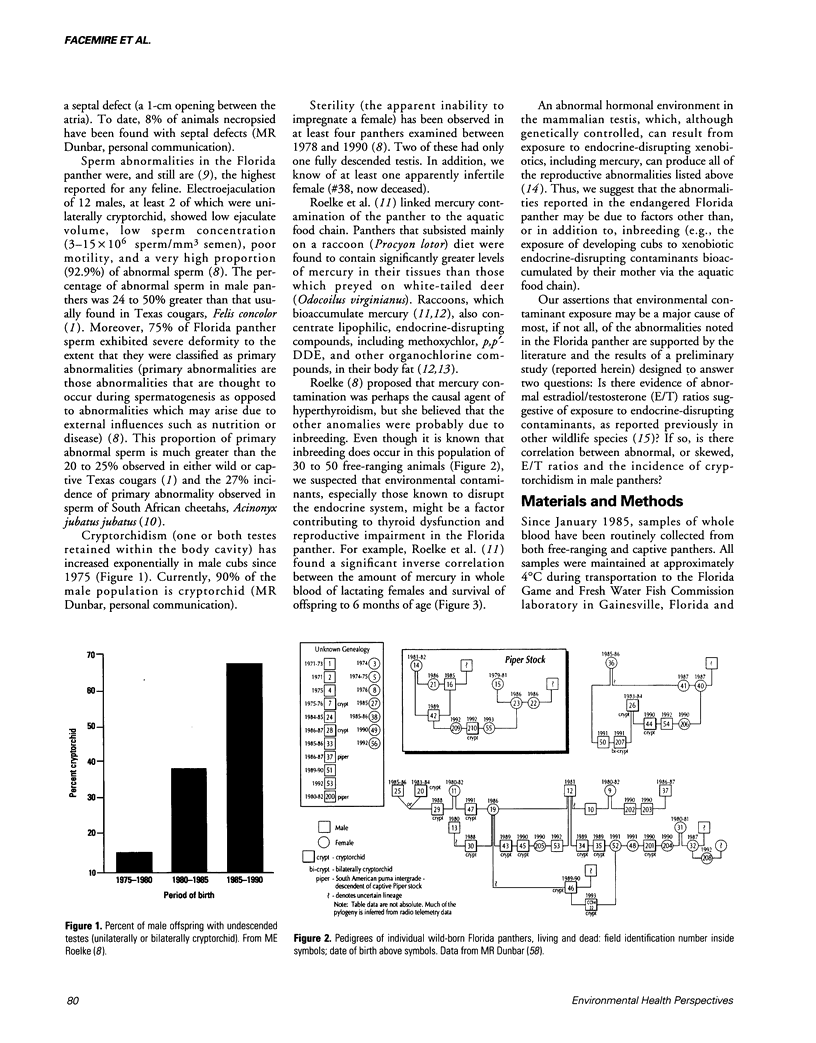
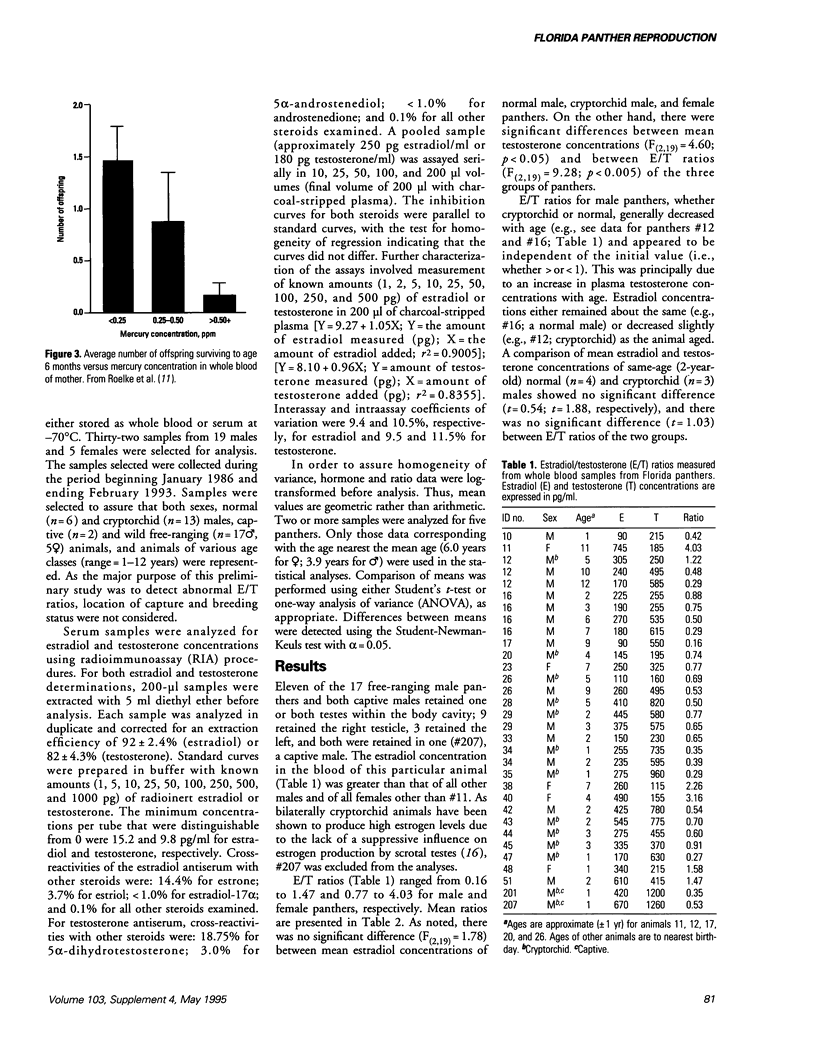
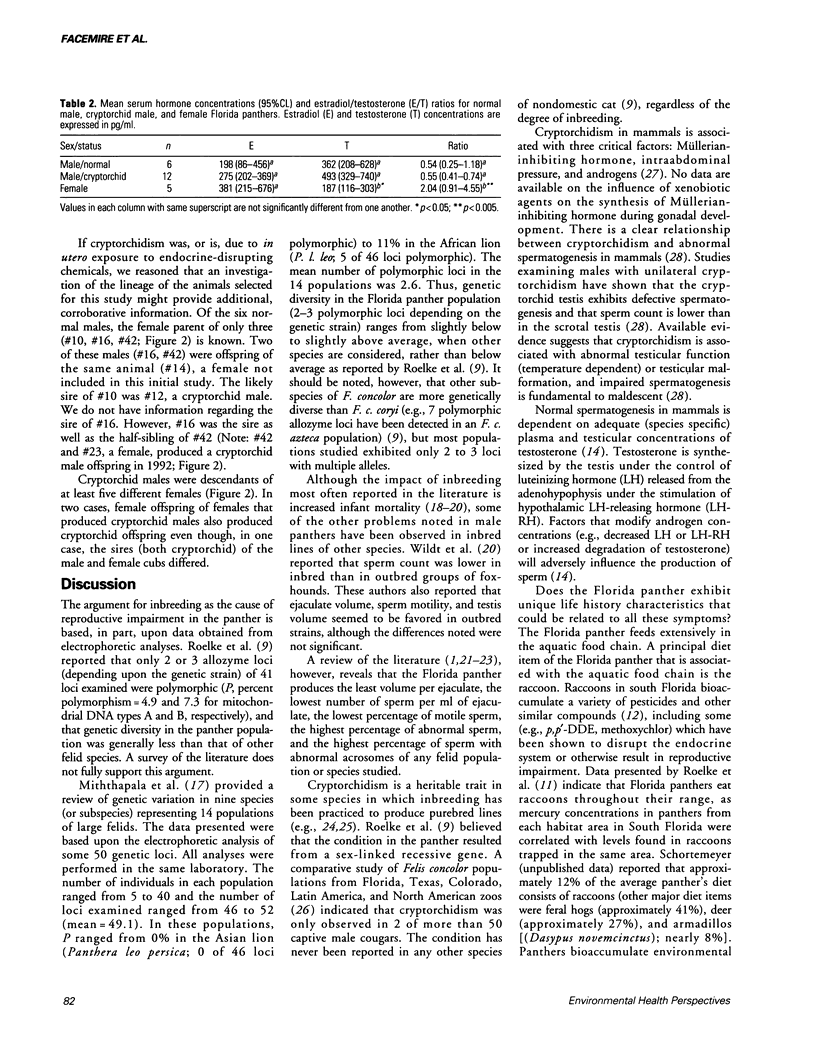
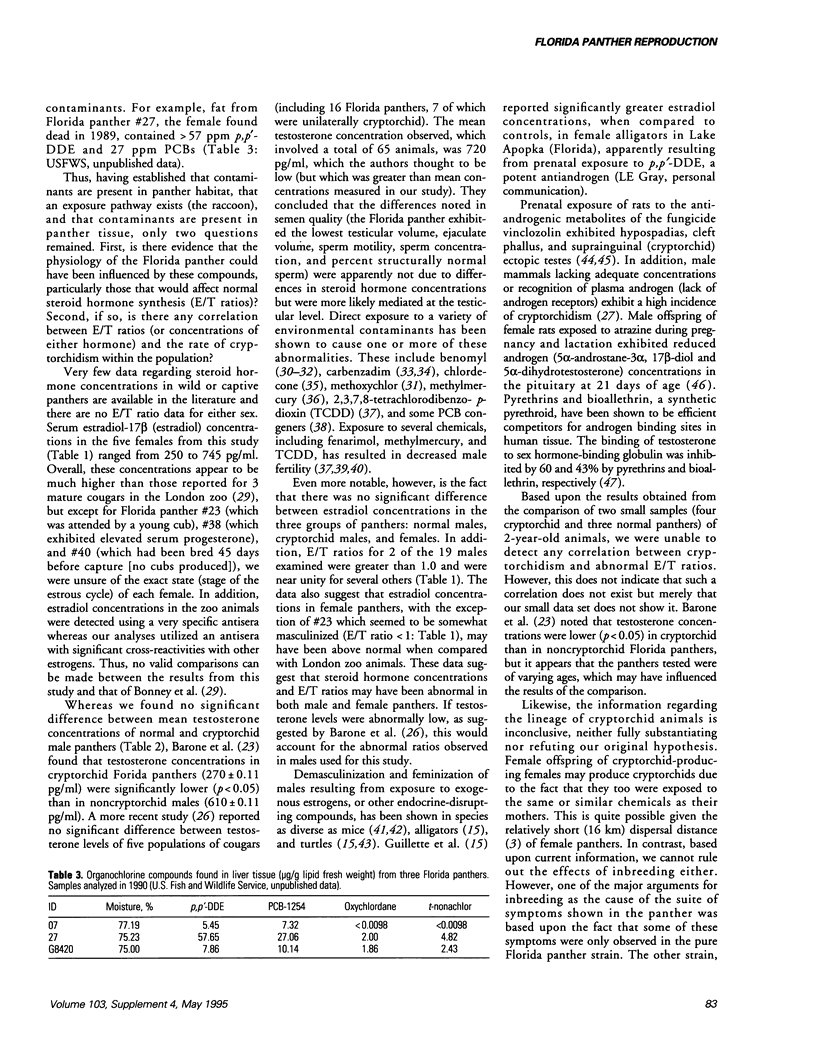
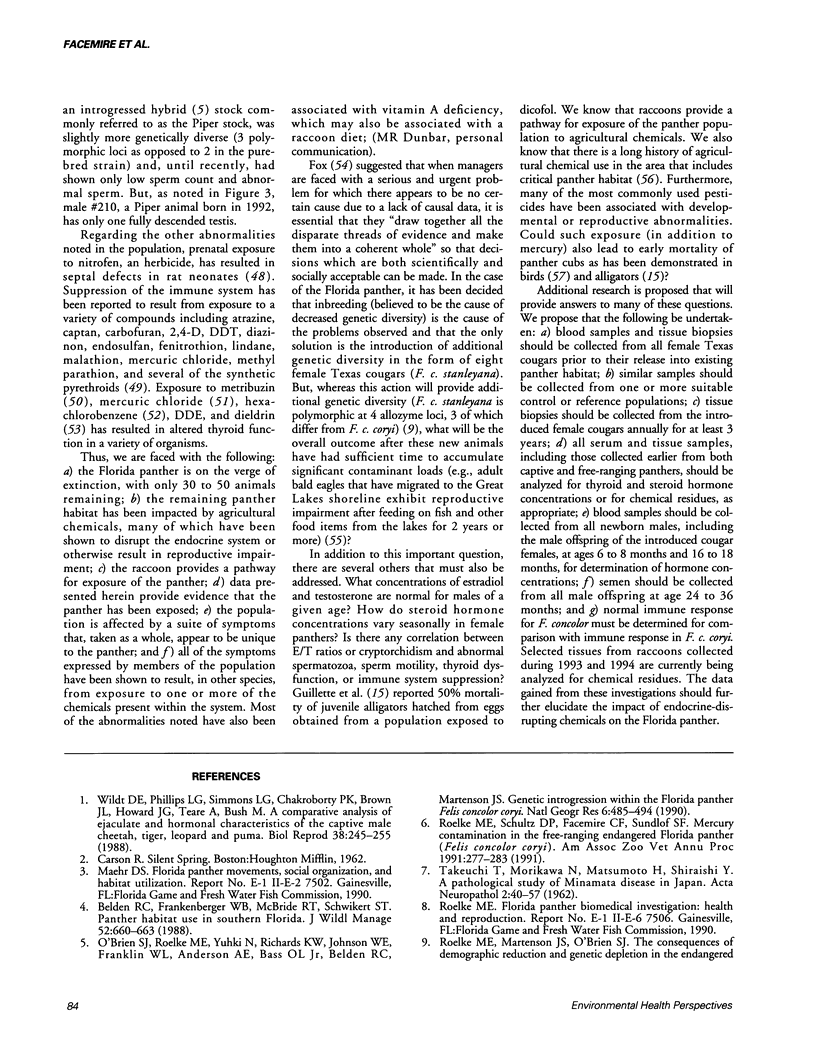
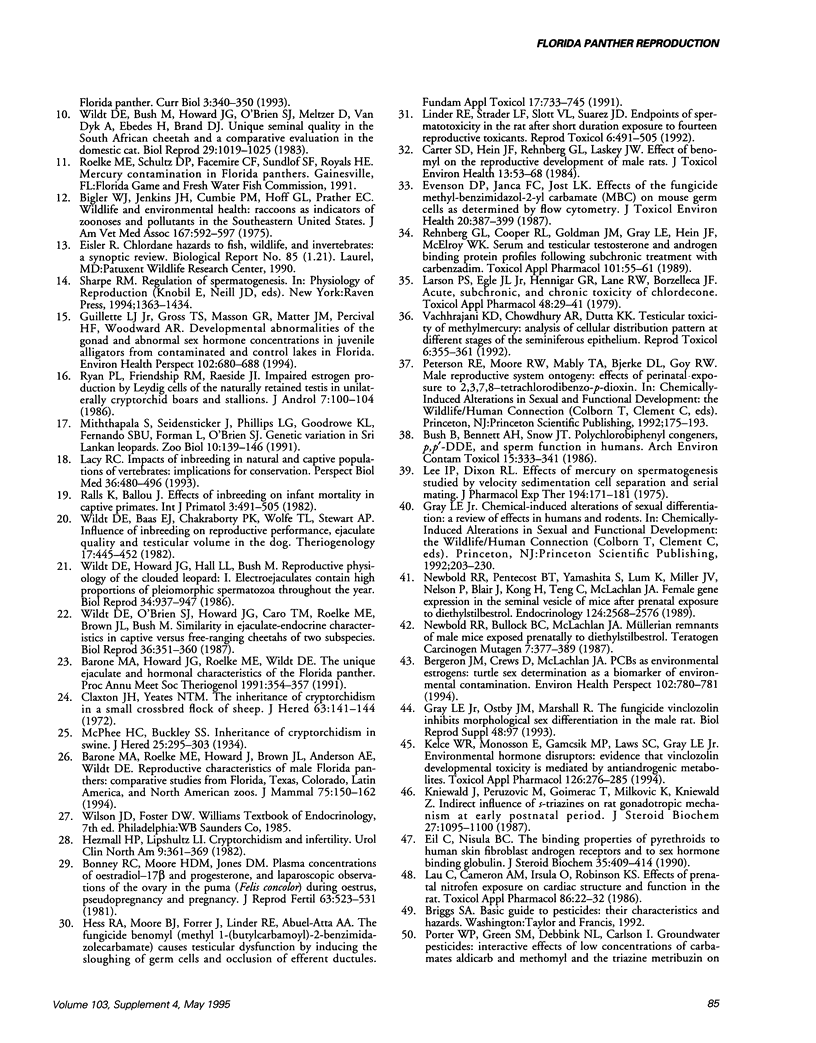
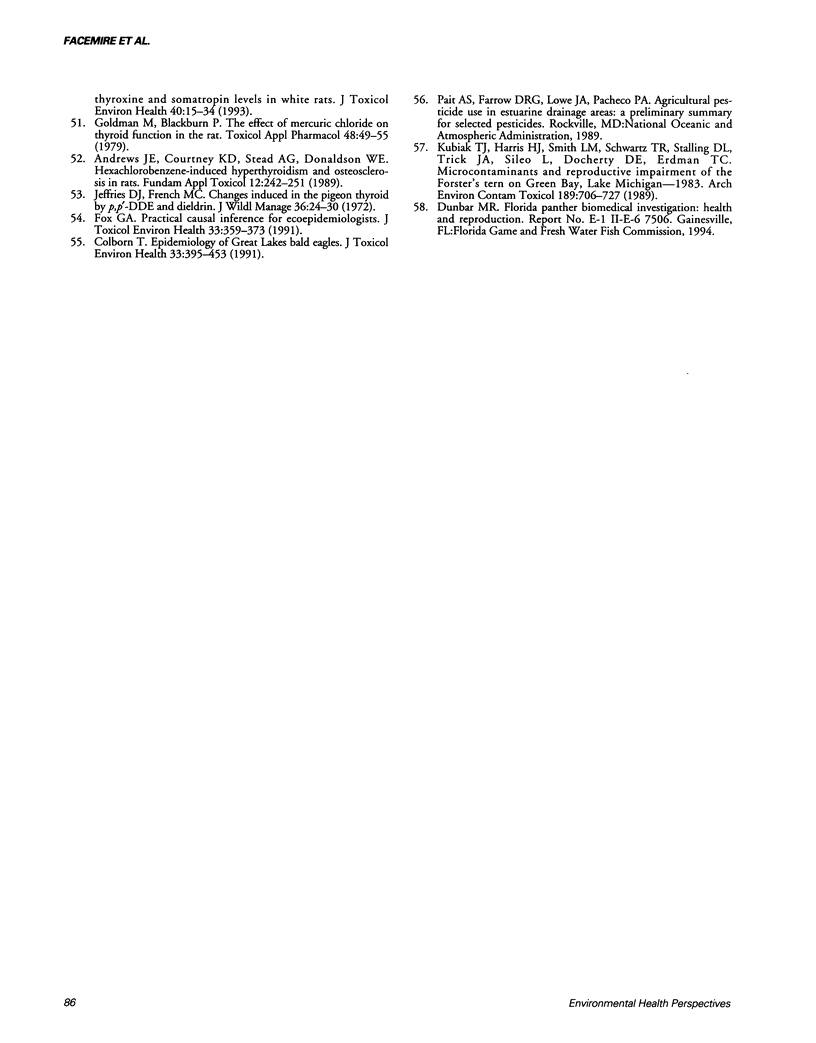
Selected References
These references are in PubMed. This may not be the complete list of references from this article.
- Andrews J. E., Courtney K. D., Stead A. G., Donaldson W. E. Hexachlorobenzene-induced hyperparathyroidism and osteosclerosis in rats. Fundam Appl Toxicol. 1989 Feb;12(2):242–251. [PubMed] [Google Scholar]
- Bergeron J. M., Crews D., McLachlan J. A. PCBs as environmental estrogens: turtle sex determination as a biomarker of environmental contamination. Environ Health Perspect. 1994 Sep;102(9):780–781. doi: 10.1289/ehp.94102780. [DOI] [PMC free article] [PubMed] [Google Scholar]
- Bigler W. J., Jenkins J. H., Cumbie P. M., Hoff G. L., Prather E. C. Wildlife and environmental health: raccoons as indicators of zoonoses and pollutants in southeastern United States. J Am Vet Med Assoc. 1975 Oct 1;167(7):592–597. [PubMed] [Google Scholar]
- Bonney R. C., Moore H. D., Jones D. M. Plasma concentrations of oestradiol-17 beta and progesterone, and laparoscopic observations of the ovary in the puma (Felis concolor) during oestrus, pseudopregnancy and pregnancy. J Reprod Fertil. 1981 Nov;63(2):523–531. doi: 10.1530/jrf.0.0630523. [DOI] [PubMed] [Google Scholar]
- Bush B., Bennett A. H., Snow J. T. Polychlorobiphenyl congeners, p,p'-DDE, and sperm function in humans. Arch Environ Contam Toxicol. 1986 Jul;15(4):333–341. doi: 10.1007/BF01066399. [DOI] [PubMed] [Google Scholar]
- Carter S. D., Hein J. F., Rehnberg G. L., Laskey J. W. Effect of benomyl on the reproductive development of male rats. J Toxicol Environ Health. 1984;13(1):53–68. doi: 10.1080/15287398409530481. [DOI] [PubMed] [Google Scholar]
- Claxton J. H., Yeates N. T. The inheritance of cryptorchism in a small crossbed flock of sheep. J Hered. 1972 May-Jun;63(3):141–144. doi: 10.1093/oxfordjournals.jhered.a108254. [DOI] [PubMed] [Google Scholar]
- Colborn T. Epidemiology of Great Lakes bald eagles. J Toxicol Environ Health. 1991 Aug;33(4):395–453. doi: 10.1080/15287399109531537. [DOI] [PubMed] [Google Scholar]
- Eil C., Nisula B. C. The binding properties of pyrethroids to human skin fibroblast androgen receptors and to sex hormone binding globulin. J Steroid Biochem. 1990 Mar;35(3-4):409–414. doi: 10.1016/0022-4731(90)90248-q. [DOI] [PubMed] [Google Scholar]
- Evenson D. P., Janca F. C., Jost L. K. Effects of the fungicide methyl-benzimidazol-2-yl carbamate (MBC) on mouse germ cells as determined by flow cytometry. J Toxicol Environ Health. 1987;20(4):387–399. doi: 10.1080/15287398709530992. [DOI] [PubMed] [Google Scholar]
- Fox G. A. Practical causal inference for ecoepidemiologists. J Toxicol Environ Health. 1991 Aug;33(4):359–373. doi: 10.1080/15287399109531535. [DOI] [PubMed] [Google Scholar]
- Goldman M., Blackburn P. The effect of mercuric chloride on thyroid function in the rat. Toxicol Appl Pharmacol. 1979 Mar 30;48(1 Pt 1):49–55. doi: 10.1016/s0041-008x(79)80007-1. [DOI] [PubMed] [Google Scholar]
- Guillette L. J., Jr, Gross T. S., Masson G. R., Matter J. M., Percival H. F., Woodward A. R. Developmental abnormalities of the gonad and abnormal sex hormone concentrations in juvenile alligators from contaminated and control lakes in Florida. Environ Health Perspect. 1994 Aug;102(8):680–688. doi: 10.1289/ehp.94102680. [DOI] [PMC free article] [PubMed] [Google Scholar]
- Hess R. A., Moore B. J., Forrer J., Linder R. E., Abuel-Atta A. A. The fungicide benomyl (methyl 1-(butylcarbamoyl)-2-benzimidazolecarbamate) causes testicular dysfunction by inducing the sloughing of germ cells and occlusion of efferent ductules. Fundam Appl Toxicol. 1991 Nov;17(4):733–745. doi: 10.1016/0272-0590(91)90181-3. [DOI] [PubMed] [Google Scholar]
- Hezmall H. P., Lipshultz L. I. Cryptorchidism and infertility. Urol Clin North Am. 1982 Oct;9(3):361–369. [PubMed] [Google Scholar]
- Kelce W. R., Monosson E., Gamcsik M. P., Laws S. C., Gray L. E., Jr Environmental hormone disruptors: evidence that vinclozolin developmental toxicity is mediated by antiandrogenic metabolites. Toxicol Appl Pharmacol. 1994 Jun;126(2):276–285. doi: 10.1006/taap.1994.1117. [DOI] [PubMed] [Google Scholar]
- Kniewald J., Peruzović M., Gojmerac T., Milković K., Kniewald Z. Indirect influence of s-triazines on rat gonadotropic mechanism at early postnatal period. J Steroid Biochem. 1987;27(4-6):1095–1100. doi: 10.1016/0022-4731(87)90195-6. [DOI] [PubMed] [Google Scholar]
- Kubiak T. J., Harris H. J., Smith L. M., Schwartz T. R., Stalling D. L., Trick J. A., Sileo L., Docherty D. E., Erdman T. C. Microcontaminants and reproductive impairment of the Forster's tern on Green Bay, Lake Michigan--1983. Arch Environ Contam Toxicol. 1989 Sep;18(5):706–727. doi: 10.1007/BF01225009. [DOI] [PubMed] [Google Scholar]
- Larson P. S., Egle J. L., Jr, Hennigar G. R., Lane R. W., Borzelleca J. F. Acute, subchronic, and chronic toxicity of chlordecone. Toxicol Appl Pharmacol. 1979 Mar 30;48(1 Pt 1):29–41. doi: 10.1016/s0041-008x(79)80005-8. [DOI] [PubMed] [Google Scholar]
- Lau C., Cameron A. M., Irsula O., Robinson K. S. Effects of prenatal nitrofen exposure on cardiac structure and function in the rat. Toxicol Appl Pharmacol. 1986 Oct;86(1):22–32. doi: 10.1016/0041-008x(86)90396-0. [DOI] [PubMed] [Google Scholar]
- Lee I. P., Dixon R. L. Effects of mercury on spermatogenesis studied by velocity sedimentation cell separation and serial mating. J Pharmacol Exp Ther. 1975 Jul;194(1):171–181. [PubMed] [Google Scholar]
- Linder R. E., Strader L. F., Slott V. L., Suarez J. D. Endpoints of spermatotoxicity in the rat after short duration exposures to fourteen reproductive toxicants. Reprod Toxicol. 1992;6(6):491–505. doi: 10.1016/0890-6238(92)90034-q. [DOI] [PubMed] [Google Scholar]
- Newbold R. R., Bullock B. C., McLachlan J. A. Müllerian remnants of male mice exposed prenatally to diethylstilbestrol. Teratog Carcinog Mutagen. 1987;7(4):377–389. doi: 10.1002/tcm.1770070405. [DOI] [PubMed] [Google Scholar]
- Newbold R. R., Pentecost B. T., Yamashita S., Lum K., Miller J. V., Nelson P., Blair J., Kong H., Teng C., McLachlan J. A. Female gene expression in the seminal vesicle of mice after prenatal exposure to diethylstilbestrol. Endocrinology. 1989 May;124(5):2568–2576. doi: 10.1210/endo-124-5-2568. [DOI] [PubMed] [Google Scholar]
- Rehnberg G. L., Cooper R. L., Goldman J. M., Gray L. E., Hein J. F., McElroy W. K. Serum and testicular testosterone and androgen binding protein profiles following subchronic treatment with carbendazim. Toxicol Appl Pharmacol. 1989 Oct;101(1):55–61. doi: 10.1016/0041-008x(89)90211-1. [DOI] [PubMed] [Google Scholar]
- Roelke M. E., Martenson J. S., O'Brien S. J. The consequences of demographic reduction and genetic depletion in the endangered Florida panther. Curr Biol. 1993 Jun 1;3(6):340–350. doi: 10.1016/0960-9822(93)90197-v. [DOI] [PubMed] [Google Scholar]
- Ryan P. L., Friendship R. M., Raeside J. I. Impaired estrogen production by Leydig cells of the naturally retained testis in unilaterally cryptorchid boars and stallions. J Androl. 1986 Mar-Apr;7(2):100–104. doi: 10.1002/j.1939-4640.1986.tb00888.x. [DOI] [PubMed] [Google Scholar]
- Vachhrajani K. D., Chowdhury A. R., Dutta K. K. Testicular toxicity of methylmercury: analysis of cellular distribution pattern at different stages of the seminiferous epithelium. Reprod Toxicol. 1992;6(4):355–361. doi: 10.1016/0890-6238(92)90199-4. [DOI] [PubMed] [Google Scholar]
- Wildt D. E., Baas E. J., Chakraborty P. K., Wolfle T. L., Stewart A. P. Influence of inbreeding on reproductive performance, ejaculate quality and testicular volume in the dog. Theriogenology. 1982 Apr;17(4):445–452. doi: 10.1016/0093-691x(82)90026-7. [DOI] [PubMed] [Google Scholar]
- Wildt D. E., Bush M., Howard J. G., O'Brien S. J., Meltzer D., Van Dyk A., Ebedes H., Brand D. J. Unique seminal quality in the South African cheetah and a comparative evaluation in the domestic cat. Biol Reprod. 1983 Nov;29(4):1019–1025. doi: 10.1095/biolreprod29.4.1019. [DOI] [PubMed] [Google Scholar]
- Wildt D. E., Howard J. G., Hall L. L., Bush M. Reproductive physiology of the clouded leopard: I. Electroejaculates contain high proportions of pleiomorphic spermatozoa throughout the year. Biol Reprod. 1986 Jun;34(5):937–947. doi: 10.1095/biolreprod34.5.937. [DOI] [PubMed] [Google Scholar]
- Wildt D. E., O'Brien S. J., Howard J. G., Caro T. M., Roelke M. E., Brown J. L., Bush M. Similarity in ejaculate-endocrine characteristics in captive versus free-ranging cheetahs of two subspecies. Biol Reprod. 1987 Mar;36(2):351–360. doi: 10.1095/biolreprod36.2.351. [DOI] [PubMed] [Google Scholar]
- Wildt D. E., Phillips L. G., Simmons L. G., Chakraborty P. K., Brown J. L., Howard J. G., Teare A., Bush M. A comparative analysis of ejaculate and hormonal characteristics of the captive male cheetah, tiger, leopard, and puma. Biol Reprod. 1988 Mar;38(2):245–255. doi: 10.1095/biolreprod38.2.245. [DOI] [PubMed] [Google Scholar]


